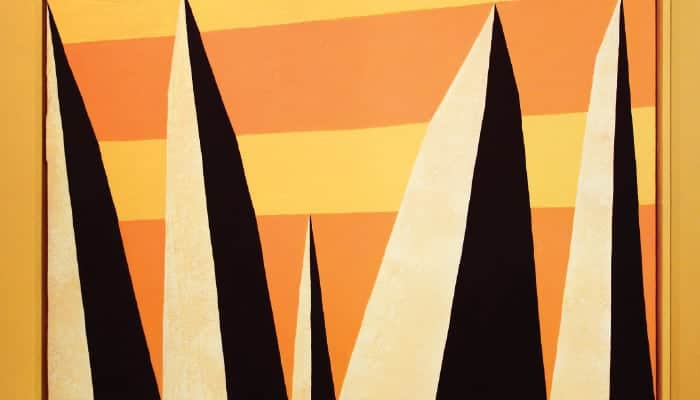In retrospect, painter Don Christensen was always headed for a career in art despite not embracing it as a career till midlife. As a kid, growing up in a small Nebraska farm town, he was always the artistic son while his older brother was the athletic one. “I was always drawing,” he says. But the family dynamics changed and his brother became an artist first. And quite a successful one. When his brother attended art school, Christensen says: “It really pissed me off. I didn’t want to compete with my brother.”
Instead he became a professional musician, playing in several bands, the last of which was the Raybeats, a neo-surf rock combo, according to Wikipedia. “We were making a living,” he says. The group was touring and cutting record deals, however, it disbanded in 1984. “There we were in our late thirties running around the country in Econoline vans playing rock ‘n’ roll for kids. “We just kind of looked at each other and said, let’s call it a day.”
At age 40 he opened a recording studio and “started making paintings for the fun of it,” he says. “Next thing I know I’m doing it after work and on weekends.” Things changed for him after the summer of 1990, which he spent in East Hampton for the first time. He returned to the city that fall, then turned around and came back for good.
“I got lucky. Within a couple of years, I got grants.” Indeed, one was one of the last individual arts fellowships awarded by the National Endowment for the Arts. He also held his first solo show at the Douglas Drake Gallery on 57th Street in the city, where he displayed his first go at painting crosses. The show generated wide recognition.

His intent was to explore the relationships of colors. “But I wanted to do it simply — cross two lines with two different colors and put them on a background of another color; that sets up a lot of possibilities.” One reviewer wrote that the paintings resembled musical chords, which makes a lot of sense considering that Christensen “looks for harmony” is his compositions. “There is a single blend of sound even though you can see the individual notes.”
Those early crosses were painted mostly on discarded wood he collected at building sites. The artist still paints predominantly found objects, but now he haunts yard sales on the lookout for step stools and tables. His initial work on tables didn’t work for him till he had a brainstorm and hung the tables on the wall sideways by the legs, making the tabletop the canvas.
He believes that mixing such whimsical pieces gives his “Modernist formalism, what they used to call ‘high art,’ more of a folky outsider thing. I think that is the attraction for me.” He showed several of these at a group show at the Parrish Art Museum alongside works by such artists as Laurie Anderson and Keith Sonnier.
Perhaps what makes Christensen’s works stand out the most is his use of highly saturated bright pigments, or what he calls “up colors.” His choice of colors is “totally intuitive,” he says. “My color theory is that no color exists on its own, only in relation to other colors.” More than an intellectual exercise, his use of color enables him to enter a creative zone. “If you want to put red paint on something, go with it,” he says. “That sounds like it’s easy but it’s not, especially after you’ve been working awhile. You start thinking about other art you’ve seen, your audience and the market – or even mowing the lawn. You have to stay with that pure place of impulse to do something that’s not married to any reason to be doing it. It’s hard to maintain that state of mind. You have to trust yourself.”












!['The Maples' is a prestigious generational compound of two extraordinary estates: 18 Maple and 22 Maple. This rare offering, designed by luxury architect Lissoni partners New York and developed by visionaries Alessandro Zampedri-CFF Real Estate and JK Living, redefines opulence with the highest quality of craftsmanship and captivating views of the Atlantic Ocean. Represented by @nycsilversurfer and @challahbackgirl of @douglaselliman. [link in bio]](https://hamptonsrealestateshowcase.com/wp-content/uploads/sb-instagram-feed-images/438891010_1083749139481747_7890082604579275354_nfull.jpg)
![Featuring 360-degree water views on Mecox Bay, the Atlantic Ocean and Channel Pond, 1025 Flying Point offers the ultimate beach cottage that is flooded with natural light. With panoramic views, proximity to the ocean, and a private walkway to Mecox bay for kayaking or paddle boarding, this truly is a special retreat. Represented by @ritcheyhowe.realestate and @hollyhodderhamptons of @sothebysrealty. [link in bio]](https://hamptonsrealestateshowcase.com/wp-content/uploads/sb-instagram-feed-images/438994305_737511778456166_4602476013493875279_nfull.jpg)
![Attention advertisers! 📣 Secure your spot in the highly anticipated Memorial Day edition #HRES. Reach thousands of potential clients and showcase your brand in one of the most sought-after publications in the Hamptons, NYC, Palm Beach, and beyond. Contact us now to reserve your ad space! [link in bio]](https://hamptonsrealestateshowcase.com/wp-content/uploads/sb-instagram-feed-images/438549843_275102939023235_6718257301437562124_nfull.jpg)
![You eat with your eyes, and on the East End, it’s important that what you eat looks just as good as how it tastes. At @rosies.amagansett, the restaurant itself is plenty photo-worthy with blue ceramic tiling and yellow and white striped fabric wallpaper. But for a dish that will light up your photos, head directly to the salmon tartare! [link in bio]](https://hamptonsrealestateshowcase.com/wp-content/uploads/sb-instagram-feed-images/437094269_7296727147115953_1594410326824303644_nfull.jpg)

![We were honored to be the media sponsor for @blackmountaincapital's open house event with @jameskpeyton and @jfrangeskos at 11 Dering Lane in East Hampton! Other sponsors included @landrover, Feline Vodka, @rustikcakestudio, @la_parmigiana, @lahaciendamexicangrill11968, @homesteadwindows, Stone Castle, @talobuilders, and @thecorcorangroup.
A big thank you Carrie Brudner of Black Mountain Capital for putting together this fabulous event! [link in bio]](https://hamptonsrealestateshowcase.com/wp-content/uploads/sb-instagram-feed-images/437081213_762912965932136_6847332836522786568_nfull.jpg)

![Blooms Galore at the Long Island Tulip Festival! 🌷✨ Mark your calendars for April 15th as the vibrant tulips at @waterdrinkerlongisland burst into full bloom! Enjoy a day filled with colorful splendor, food trucks, live music, and more. [link in bio]](https://hamptonsrealestateshowcase.com/wp-content/uploads/sb-instagram-feed-images/437083429_974242677583725_6855805712693638343_nfull.jpg)
